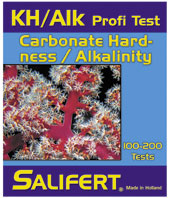
Salifert Alkalinity Test Kit
Salifert KH/Alkalinity Profi-Test
- Calcium is not the only substance needed to form the skeletal material of corals and allow calcareous algae to grow. Carbonate and bicarbonate are also needed and these two substances can have a major effect on stabilizing or buffering pH levels in the aquarium in the correct range of 8.1 to 8.4.
- The total carbonate and bicarbonate concentration is also called alkalinity or carbonate hardness and for a stable system the alkalinity should not fluctuate by more than 5% from the optimum level of approx. 2.8 meq/L i.e. a maximum fluctuation of 0.14 meq/L.
- The Salifert test is sensitive enough to detect small changes in levels of alkalinity, measuring in steps of 0.1 meq/L and demonstrating a very sharp color change.
- Sufficient for 100 to 200 tests.
- The Salifert KH + pH buffer additive makes correction of the alkalinity or carbonate hardness simple and does not upset the pH of the system
- Can be used for marine water, frewshwater and garden pond water
Warning!
The KH/Alkalinity reageant contains a dye. Avoid spilling the dye on fabric and other materials since they may become stained. Keep out of reach of children. Not for consumption.
Instructions:
- Add with the 5 ml syringe 4 ml of water in the test vial. For a lower resolution and more tests per kit add 2 instead of 4 ml.
- Shake the KH-Ind dropping bottle a few times and add 2 drops in the test vial (1 drop for the low resolution mode).
- Put the plastic tip firmly on the 1 ml syringe. And draw into the syringe the KH reagent (ensure that the end of the plastic tip is constantly submersed in the KH reagent) till the lower end of the black part of the piston is exactly at the 1.00 ml mark. There will be some air present just below the piston. This is the air which was present between the end of the plastic tip and the piston. This will not influence the test result.
- Add dropwise with the 1 ml syringe the KH reagent to the water in the test tube. Swirl after each drop a second or two. Continue with this until the color changes from blue/green to orange-red or pink color (whichever color is observed first).
- Hold the syringe with the tip facing upward and read the position of the, now the upper end, of the black part of the piston. The syringe has graduations of 0.01 ml. Read the KH or alkalinity value from the table or calculate as follows.
KH in dKH = (1 - reading in step 5) x 16
Alk in meq/L = (1 - reading in step 5) x 5.71
If you have chosen for the lower resolution multiply the calculated result by 2.
Natural sea water has a KH of 8 dKH or alkalinity of 2.9 meq/L
KH and alkalinity are increased safely with Salifert`sKH + pH Buffer.
